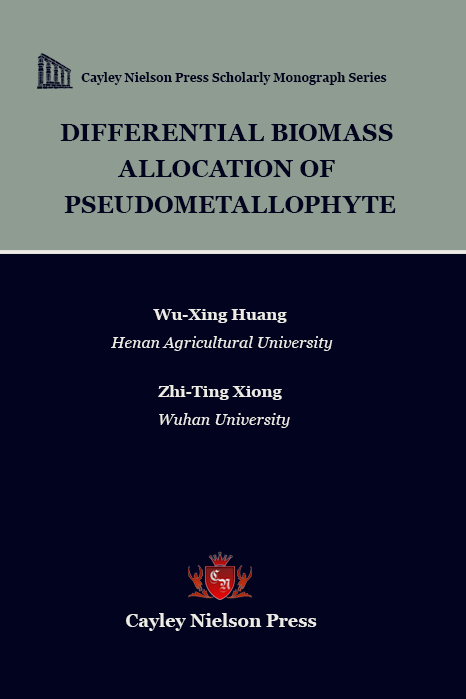
Differential Biomass Allocation of Pseudometallophyte

Wu-Xing Huang
Henan Agricultural University
Zhi-Ting Xiong
Wuhan University
Copyright © 2016 by Cayley Nielson Press, Inc.
ISBN: 978-0-692-57596-3
Cayley Nielson Press Scholarly Monograph Series Book Code No.: 129-5-6
US$98.00
Preface
Metallophytes are special plants that live in the environment with heavy metal content which is much higher than that in normal soils and that have been evolved with heavy metal resistance. They are the results of heavy metal poisons in soils on plants for decades, hundreds of, even millions of years. The distribution range of metallophytes varies greatly for different species: some species are widely distributed in large areas, while others are only distributed in specific areas, or even only scattered in single veins. Thus, Ernst divided metallophytes into “original-metallophytes” and “anthropogenic-metallophytes” two groups according to their habit heterogeneities. The former refers to metallophytes that live in ore bodies without human interferences (such as mineralized zones, suboutcrops, etc.). The latter refers to metallophytes that origin from some plants in normal soils which as a result of heavy metal pollutions in soils from human activities (such as mines, waste lands of mining, smelters, etc), gradually form heavy metal resistance during the processes of community succession and biological evolution and then finally make the ecesis in polluted soils. As the anthropogenic-metallophyte can not only live in soils enriched in heavy metals, but also live in normal soils, it is also called “pseudometallophyte” and “facultative metallophyte”......
Contents
Preface.................................................................................................................................................. III
1 Cu Pollution, Metallophytes and Biomass Allocation.........................................................1
1.1 Sources of Cu Pollution......................................................................................................... 1
1.2 Toxicity of Cu................................................................................................................................ 3
1.3 Metallophytes............................................................................................................................ 5
1.3.1 Definition and Classification of Metallophytes............................................... 5
1.3.2 Resistance Evolution of Metallophytes................................................................. 6
1.3.3 Resistance Mechanism of Metallophytes................................................................ 9
1.3.4 Phytoremediation by Metallophytes..................................................................... 12
1.4 Biomass Allocation................................................................................................................ 15
1.4.1 Biomass Allocation of Root/Shoot.......................................................................... 15
1.4.2 Biomass Allocation of Growth/Reproduction.................................................. 16
1.4.3 Sucrose Metabolism of Biomass Allocation........................................................ 18
1.5 Invertase..................................................................................................................................... 20
1.5.1 Biological Characteristics............................................................................................ 20
1.5.2 Molecular Characteristics............................................................................................ 21
1.5.3 Expression and Regulation............................................................................................ 23
1.6 Studies on Biomass Allocation of Pseudometallophyte................................ 24
2 Metallophyte Biomass Allocation.................................................................................. 28
2.1 Introduction............................................................................................................................. 28
2.2 Materials and Methods...................................................................................................... 30
2.2.1 Hydroponic Experiment................................................................................................... 33
2.2.2 Soil Culture Experiment.................................................................................................. 33
2.3 Results........................................................................................................................................... 36
2.3.1 Biomass and Root/Shoot Ratio.................................................................................... 36
2.3.2 Morphological Character............................................................................................. 38
2.3.3 Phenological Character................................................................................................. 39
2.3.4 Reproduction Character................................................................................................ 42
2.4 Discussion..................................................................................................................................... 46
2.5 Brief Summary........................................................................................................................... 50
3 Sucrose Metabolism Mechanism of Differential Biomass Allocation........ 52
3.1 Introduction............................................................................................................................. 52
3.2 Materials and Methods...................................................................................................... 54
3.2.1 Plant Culture and Cu Treatment.............................................................................. 54
3.2.2 Measurement of Sucrose Synthase Activity........................................................ 55
3.3 Results........................................................................................................................................... 56
3.3.1 Sucrose Metabolism Enzyme Activity in Roots................................................... 56
3.3.2 Sucrose Metabolism Enzyme Activity in Seeds.................................................... 60
3.4 Discussion..................................................................................................................................... 64
3.5 Brief Summary........................................................................................................................... 68
4 Metallophyte Acid Invertases Genes Sequence....................................................... 69
4.1 Preface.......................................................................................................................................... 69
4.2 Materials and Methods...................................................................................................... 70
4.2.1 Experimental Materials.................................................................................................. 70
4.2.2 Plant Cultivation and Copper Treatment........................................................... 70
4.2.3 Total RNA Extract and cDNA First Strand Synthesis...................................... 71
4.2.3.1 Total RNA Extract........................................................................................................... 71
4.2.3.2 Total RNA Electrophoretic Analysis.................................................................... 72
4.2.3.3 Total RNA DNase Treatment...................................................................................... 73
4.2.3.4 First Strand cDNA Synthesizing................................................................................ 74
4.2.4 Clone of Intermediate Fragments........................................................................... 75
4.2.4.1 Design of Degenerate Primers................................................................................. 75
4.2.4.2 PCR Amplification of Intermediate Fragments.............................................. 77
4.2.4.3 Recycle and Purification............................................................................................. 78
4.2.4.4 Tailing Reaction of Recycled Products.............................................................. 80
4.2.4.5 Connection between PCR Products and T-vector......................................... 80
4.2.4.6 Conversion of DH5α Competent Cell.................................................................... 80
4.2.4.7 Identification and Sequencing of Positive Clone......................................... 82
4.2.5 3’RACE Experiment................................................................................................................ 83
4.2.5.1 Design of 3’RACE Primer................................................................................................. 83
4.2.5.2 Reverse Transcription Reaction............................................................................. 84
4.2.5.3 Outer PCR Reaction.......................................................................................................... 85
4.2.5.4 Inner PCR Reacting........................................................................................................... 85
4.2.5.5 Recycling, Purification, Connection, Conversion and Sequencing...... 86
4.2.6 5’RACE Experiment................................................................................................................ 87
4.2.6.1 Design of 5’RACE Primers............................................................................................... 87
4.2.6.2 First-Strand cDNA Obtained in the Total RNA................................................ 88
4.2.6.3 Elimination of Existing RNA with RNase Mix..................................................... 88
4.2.6.4 Purification of First Strand cDNA.......................................................................... 89
4.2.6.5 Trailing of cDNA Homopolymer............................................................................... 90
4.2.6.6 Amplification of cDNA with Cytosine Tail by PCR........................................... 90
4.2.6.7 Nested PCR............................................................................................................................. 92
4.2.6.8 Recycling, Purification, Connection, Conversion and Sequencing...... 93
4.2.7 cDNA Full-length Sequence Splicing and Aligning........................................... 93
4.2.8 Protein Conformation Analysis.................................................................................. 93
4.3 Results........................................................................................................................................... 94
4.3.1 RNA Quality Inspection..................................................................................................... 94
4.3.2 PCR Results of the Intermediate Fragments...................................................... 95
4.3.3 3’RACE Results......................................................................................................................... 96
4.3.4 Full-length cDNA Sequences......................................................................................... 98
4.3.5 Protein Conformation................................................................................................... 107
4.4 Discussion................................................................................................................................... 111
4.5 Brief Summary......................................................................................................................... 114
5 Metallophyte Acid Invertase Gene Transcriptional Expression................ 115
5.1 Preface........................................................................................................................................ 115
5.2 Materials and Methods.................................................................................................... 116
5.2.1 Experimental Materials............................................................................................... 116
5.2.2 Plant Cultivation and Cu Treatment................................................................... 116
5.2.3 Synthesis of cDNA First Strand.................................................................................. 117
5.2.4 Design of Primer................................................................................................................. 117
5.2.5 Real-time Fluorescence Quantification PCR..................................................... 118
5.3 Results........................................................................................................................................ 119
5.3.1 RNA Quantity Inspection................................................................................................ 119
5.3.2 Reliability Analysis.......................................................................................................... 120
5.3.3 Transcription Expression............................................................................................. 127
5.4 Discussion................................................................................................................................... 131
5.5 Brief Summary......................................................................................................................... 134
6 Subcellular Distribution and Antioxidant Enzymes Activities................... 135
6.1 Introduction........................................................................................................................... 135
6.2 Materials and methods.................................................................................................... 136
6.2.1 Plant Materials and Cu Treatments..................................................................... 136
6.2.2 Antioxidant Enzyme Assay............................................................................................ 138
6.2.3 Acid Invertase Activity Assay...................................................................................... 138
6.2.4 Cu Concentration in Cell wall, Cytoplasm and Vacuole........................... 139
6.2.5 Statistical Analysis.......................................................................................................... 140
6.3 Results........................................................................................................................................ 140
6.3.1 Antioxidant Enzymes Activities................................................................................ 140
6.3.2 Acid Invertase Activities............................................................................................... 142
6.3.3 Subcellular Cu Concentration................................................................................. 143
3.4. Correlations.......................................................................................................................... 144
6.4 Discussion................................................................................................................................... 145
6.5 Brief Summary......................................................................................................................... 147
7 Present Conclusions and Scientific Issues to Be Further Studied.............. 148
7.1 Present Conclusions........................................................................................................... 148
7.2 Scientific Issues to Be Further Studied................................................................... 150
References...................................................................................................................................... 152
Readership
This book should be useful for students, scientists, engineers and professionals working in the areas of optoelectronic packaging, photonic devices, semiconductor technology, materials science, polymer science, electrical and electronics engineering. This book could be used for one semester course on adhesives for photonics packaging designed for both undergraduate and graduate engineering students.
